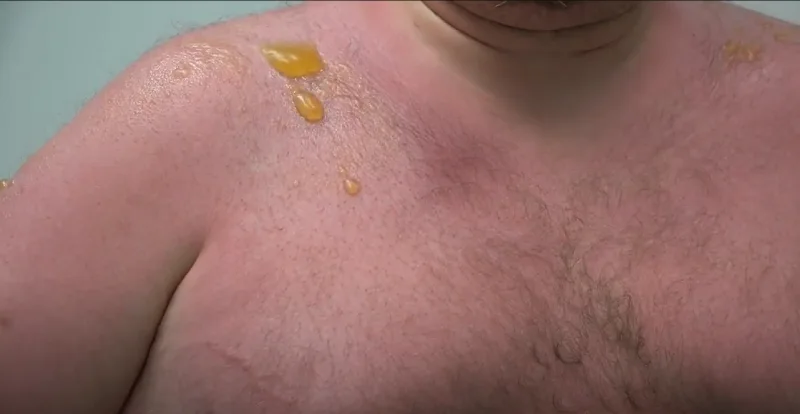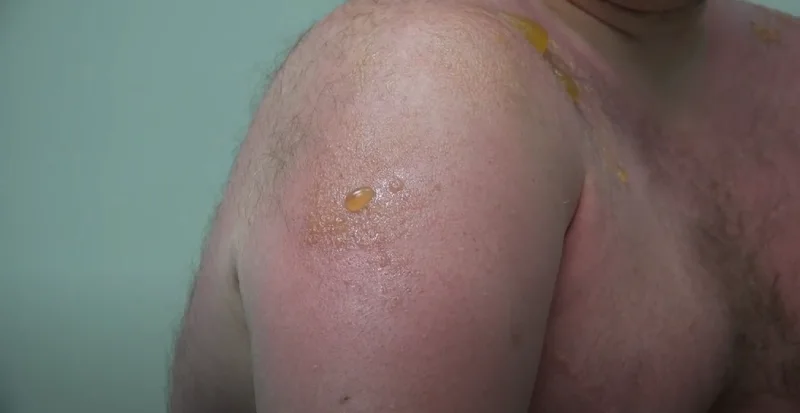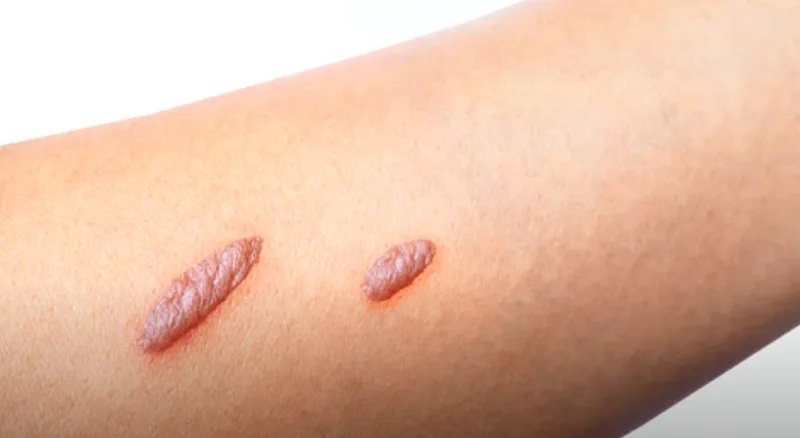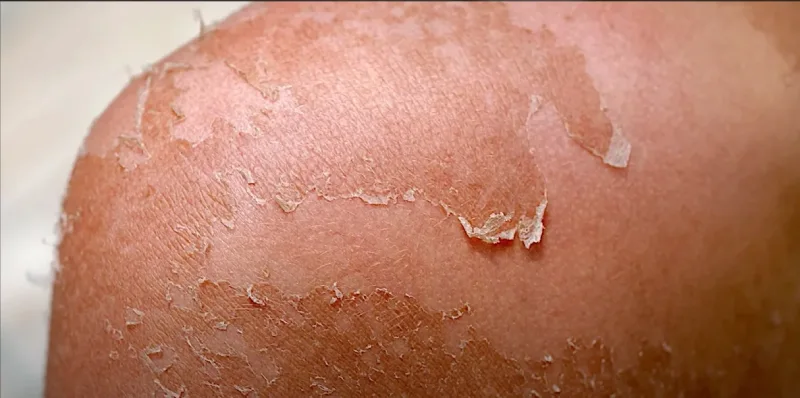A second-degree sunburn results in cyclists blisters that typically show up a few hours after exposure to the sun. In some cases, they may take up to 24 hours to appear. These blisters are small, white or transparent bumps on the skin filled with fluid, which may contain lymph, serum, plasma, blood, or pus.
Sunburn blisters leaking yellow fluid for a cyclist indicate a severe burn that needs immediate attention. The blisters are painful and can take about a week to heal, potentially leaving visible scars for 6-12 months. Melanoma and skin cancer are also associated with this type of burn.
In this blog post, we delve into the causes of sunburn blisters that release yellow fluid in cyclists. We’ll cover the 9 impacts, 10 symptoms, 13 prevention strategies, and 16 treatments for cyclists experiencing this condition.
Sunburn Blisters Leaking Yellow Fluid For Cyclist: 15 Causes

Cyclists may experience sunburn blisters with yellow fluid leakage due to prolonged sun exposure while cycling. To avoid this, cyclists should take into account factors such as extended outdoor periods, high UV levels, limited shade, and insufficient skin protection.
Prolonged Sun Exposure During Cycling
Cyclists often spend long hours outdoors, which significantly increases their exposure to ultraviolet (UV) rays. This prolonged sun exposure is a primary cause of sunburn blisters. The intensity of UV radiation can cause severe damage to the skin, leading to blister formation.
- Extended Outdoor Activity: Long cycling sessions without breaks can intensify sun exposure.
- High UV Index: Cycling during times when the UV index is high increases the risk of sunburn.
- Lack of Shade: Often, cycling routes may lack shaded areas, making it challenging to avoid direct sunlight.
Lack of Adequate Skin Protection
One of the most preventable causes of sunburn blisters is inadequate skin protection. Many cyclists underestimate the importance of using sunscreen and wearing protective clothing.
- Sunscreen: Failing to apply sunscreen or using a product with insufficient SPF can leave the skin vulnerable.
- Proper Application: Sunscreen should be applied 15-30 minutes before cycling and reapplied every two hours.
- Broad Spectrum: Use a broad-spectrum sunscreen to protect against both UVA and UVB rays.
- Protective Clothing: Wearing appropriate clothing can significantly reduce sun exposure.
- Long-Sleeved Jerseys: Opt for lightweight, long-sleeved jerseys made from UV-protective fabric.
- Cycling Caps and Helmets: Use caps and helmets with visors to shield the face and neck.
Factors That Exacerbate Sunburn Risk
Several factors can exacerbate the risk of sunburn, making it more likely for blisters to form. Cyclists should be aware of these to take necessary precautions.
- Time of Day: UV radiation is strongest between 10 a.m. and 4 p.m.
- Early Morning/Late Afternoon: Plan rides during these times to minimize exposure.
- Weather Conditions: Even on cloudy days, UV rays can penetrate and cause sunburn.
- Overcast Skies: Don’t underestimate the sun’s power on cloudy days; always use protection.
- Altitude: Higher altitudes have thinner atmospheres, leading to stronger UV radiation.
- Mountain Rides: Extra precautions are needed when cycling at higher elevations.
Sunburn Blisters on Cycling Performance: 9 Impact

Saddle sores often result from excessive sweating and skin friction. While anyone can experience saddle sores, the risk is higher after a long bike ride. Prolonged time on the saddle without breaks can hinder skin breathability, contributing to this discomfort.
Effects of Pain and Discomfort on Cycling Ability
Sunburn blisters can significantly affect a cyclist’s performance by causing intense pain and discomfort. This can lead to reduced efficiency and slower response times.
- Painful Movements: The friction between the blistered skin and cycling gear can make pedaling excruciating.
- Limited Mobility: Blisters, especially on areas that come into frequent contact with the bike, can restrict movement.
- Mental Distraction: The discomfort can divert attention from the road, increasing the risk of accidents.
Potential for Infection and Extended Recovery Time
Blisters that leak yellow fluid may indicate an infection, which can severely impact a cyclist’s health and performance.
- Infection Risks: Open blisters are prone to bacterial infections, resulting in more serious health problems.
- Extended Recovery: Treating infected blisters often requires a break from cycling, leading to a longer recovery period.
- Rest and Treatment: Proper rest and medical care are essential to a successful recovery.
- Performance Downtime: Extended recovery periods can result in a loss of conditioning and performance levels.
- Reconditioning: Cyclists may need to undergo a period of reconditioning to regain their previous performance levels
post-recovery.
Yellow Fluid Leaks From Sunburn Blisters In Cyclists: 10 Symptoms
For blisters to prevent further damage, it is crucial to recognize the early signs of sunburn. Redness and Swelling are among the initial symptoms, where the skin turns red and may swell due to inflammation.
Initial Signs of Sunburn
Recognizing the early signs of sunburn is crucial for preventing further damage and the formation of blisters.
- Redness and Swelling: The skin starts to turn swollen and red when it is inflamed.
- Warmth and Tenderness: Affected areas feel warm to the touch and tender.
- Pain and Itching: Initial exposure can cause discomfort, itching, and mild pain.
Development of Blisters and Their Characteristics
As sunburn progresses, blisters can form, indicating more severe skin damage.
- Fluid-Filled Bumps: Blisters appear as small, fluid-filled bumps on the red, sunburned skin.
- Painful Sensation: The blistered areas are often painful and sensitive to touch.
- Size and Spread: Blisters may vary in size and can cluster together, covering larger areas of the skin.
Indicators of Infection
Blisters leaking yellow fluid can be a sign of infection, requiring prompt attention.
- Yellow Fluid Leakage: The presence of yellow fluid suggests the blister might be infected.
- Increased Pain: Infected blisters become more painful than typical sunburn blisters.
- Additional Symptoms: Look for signs like increased redness, swelling, and the presence of pus.
- Fever and Chills: These systemic symptoms may accompany severe infections and necessitate medical intervention.
Sunburn Blisters in Cyclists: 13 Prevention Strategies

Sunburn blisters pose a painful challenge for cyclists who spend extended hours outdoors. Uncover essential strategies to prevent these blisters and protect your skin’s health.
Importance of Preventive Measures
Preventing sunburn blisters is crucial for cyclists who spend extended periods outdoors. Taking proactive steps can prevent the painful and potentially harmful effects of severe sunburn.
- Minimize Risk: Proper prevention reduces the risk of skin damage and blister formation.
- Enhanced Performance: Healthy skin ensures comfort and optimal performance during cycling.
- Long-term Health: Consistent preventive measures contribute to long-term skin health and lower the risk of skin cancers.
Effective Sunscreens and How to Apply Them
UV rays can severely damage the skin if sunscreen isn’t applied correctly. Heres some tpis:
- SPF Selection: Choose a sunscreen with an SPF of 30 or higher for adequate protection.
- Broad Spectrum:Choose a sunscreen that shields you from UVB and UVA rays.
- Application Tips: Make sure all exposed skin is protected with sunscreen.
- Timing: Apply sunscreen 15-30 minutes before going outdoors.
- Reapplication: Reapply every two hours, or more frequently if sweating heavily.
Protective Clothing and Gear for Cyclists
Wearing the right clothing and gear can provide an additional shield against sun exposure.
- UV-Protective Fabrics: Opt for clothing made from materials designed to block UV rays.
- Long-Sleeved Jerseys: Lightweight, long-sleeved jerseys offer protection without causing overheating.
- Leggings and Sleeves: Use UV-protective leggings and arm sleeves for additional coverage.
- Headgear: Protect your face and neck with appropriate headgear.
- Cycling Caps: Wear caps under helmets to shield the scalp and forehead.
- Helmets with Visors: Use helmets equipped with visors to provide shade for your face.
Hydration and Its Role in Skin Health
Staying hydrated promotes healthy skin, which is more resilient against sunburn.
- Daily Intake: Ensure adequate daily water intake based on your activity level and environmental conditions.
- Hydration Guidelines: Drink at least 8-10 cups of water daily, adjusting for exercise intensity and heat.
- Hydration Strategies: Implement hydration strategies before, during, and after cycling.
- Electrolyte Balance: Use sports drinks with electrolytes to maintain hydration and skin health during long rides.
Cycling Blisters Leaking Yellow Fluid: 16 Treatments
Sunburn blisters frequently affect cyclists, leading to discomfort and possible complications. Explore prompt actions and home remedies to ease the pain and expedite recovery.
Immediate Steps to Take When Blisters Form
When sunburn blisters develop, taking immediate actions can help minimize discomfort and prevent further complications.
- Cool the Area: Apply a cool, damp cloth to the blistered skin to reduce heat and swelling.
- Avoid Ice: Do not apply ice directly to the skin as it can worsen the damage.
- Clean Gently: Use mild soap and water to clean the affected area without popping the blisters.
- Avoid Friction: Wear loose clothing to minimize friction and further irritation on the blistered skin.
Home Remedies to Alleviate Discomfort
Numerous home remedies are available to ease the pain and discomfort caused by sunburn blisters.
- Aloe Vera gel: Massage into your skin and reduce inflammation.
- Natural or Store-Bought: Use either fresh aloe vera from the plant or a commercial gel.
- Oatmeal Baths: These baths soothe the skin and reduce itching.
- Preparation: Add a cup of colloidal oatmeal to a cool or warm bath and soak for 20-25 minutes.
- Hydration: Keep hydrated to support the skin’s healing process.
- Hydration Strategy: Increase water intake to counteract dehydration caused by sunburn.
Over-the-Counter Treatments

Several over-the-counter treatments can provide relief and aid in the healing of sunburn blisters.
- Pain Relievers: Use non-prescription medications with anti-inflammatory effects, such as acetaminophen or ibuprofen.
- Dosage: Read the packaging instructions carefully for suggested dosage.
- Topical Ointments: Apply over-the-counter antibiotic ointments to prevent infection in open blisters.
- Application: Spread ointment thinly over a clean, affected area and cover with a sterile bandage.
- Hydrocortisone Cream: Use a low-dose hydrocortisone cream to reduce itching and inflammation.
- Usage: Follow the instructions on the packaging for proper and safe use.
When to Seek Medical Attention
In some cases, medical attention is necessary to properly treat sunburn blisters and prevent complications.
- Signs of Infection: Seek medical help if blisters are red, swelling, yellow fluid leakage, or pus.
- Fever and Chills: Accompanying systemic symptoms like fever and chills also require prompt medical evaluation.
- Severe Blisters: Large, severe blisters covering a significant portion of the body may need professional care.
- Professional Treatment: A healthcare provider may prescribe stronger medications or perform treatments to promote
healing. - Persistent Symptoms: If blisters do not improve with home care and over-the-counter treatments, consult a healthcare professional.
- Further Evaluation: Persistent symptoms may indicate a need for additional medical intervention.
Conclusion:
Essentially, while cycling embodies endurance, speed, and the exhilaration of the journey, it’s vital not to neglect our skin’s health. Sunburn and blisters, especially those oozing yellow fluid, jeopardize not only our comfortable rides but also our overall well-being.
As we’ve discovered, it’s more than just applying sunscreen before a ride—it involves informed preventive actions, symptom recognition, and proper treatment if issues arise.
Remember, prioritizing optimal skin health is as crucial as fine-tuning your cycles. Let’s give it the attention it deserves to ensure a seamless, blister-free ride under the sun! Enjoy cycling, everyone.
FAQs
How Do Sunburn Blisters Develop?
Sunburn blisters develop as a result of excessive exposure to the sun’s ultraviolet (UV) rays. In the case of excessive UV exposure to the skin, it triggers the body’s defense mechanism, leading to inflammation and the formation of fluid-filled blisters. These blisters usually appear a few hours to a day after sun exposure and are a sign of severe sunburn.

